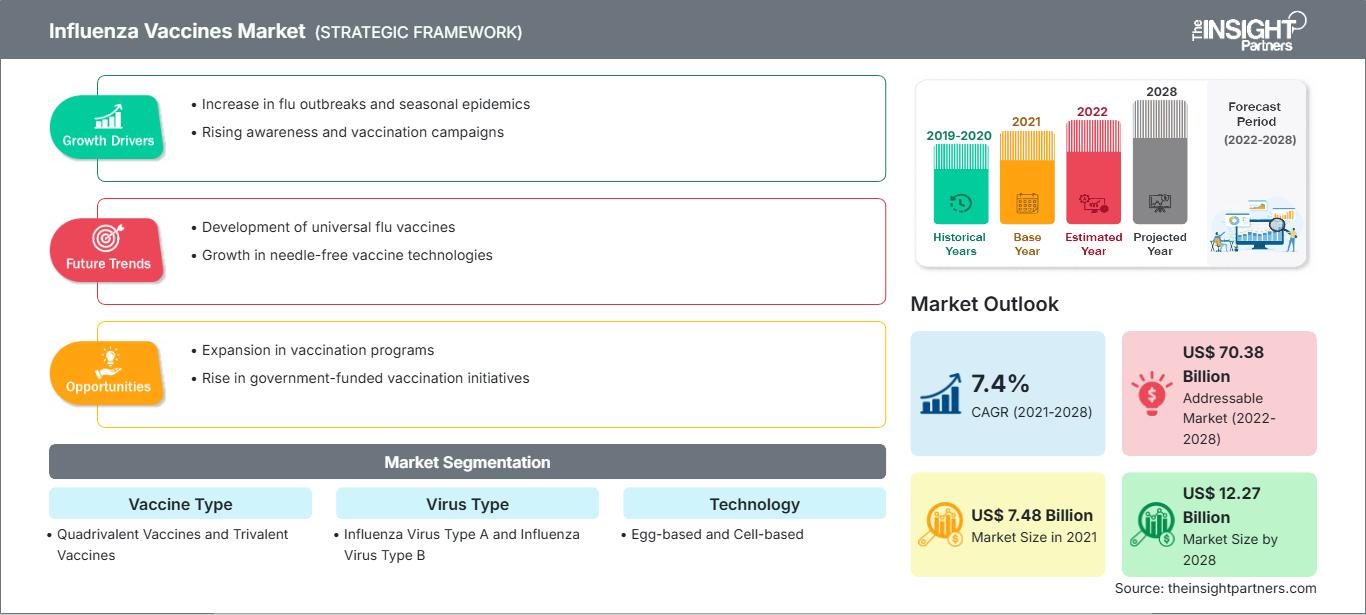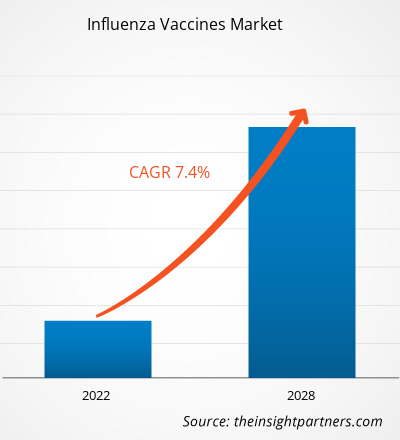Der Markt für Grippeimpfstoffe wurde im Jahr 2021 auf 7.478,53 Millionen US-Dollar geschätzt und soll bis 2028 auf 12.272,49 Millionen US-Dollar wachsen; mit einer durchschnittlichen jährlichen Wachstumsrate von 7,4 % von 2022 bis 2028
Influenza ist eine ansteckende Atemwegsinfektion, die durch das Grippevirus verursacht wird. Sie äußert sich durch Fieber, Husten, Muskel- und Gelenkschmerzen, Kopfschmerzen und starke Schwäche. Der Verlauf der Grippe kann leicht bis schwer sein und führt manchmal zum Tod. Laut der Weltgesundheitsorganisation (WHO) aus dem Jahr 2018 liegt die Zahl der Krankenhauseinweisungen aufgrund von Grippe bei 3-5 Millionen Fällen mit schwerem Verlauf, während die Zahl der Todesfälle im Zusammenhang mit Grippe zwischen 290.000 und 650.000 liegt. Impfstoffe werden zur Vorbeugung von Grippeinfektionen empfohlen. Die rasante Ausbreitung von Grippeepidemien weltweit treibt die Nachfrage nach der Entwicklung eines wirksamen Grippeimpfstoffs voran. Eine starke Produktpipeline ist ein Schlüsselfaktor für das Marktwachstum im Prognosezeitraum.
Der Markt für Grippeimpfstoffe wird anhand von Impfstofftyp, Virustyp, Technologie, Verabreichungsweg, Zielgruppe und geografischer Lage analysiert. Geografisch ist der Markt grob in Nordamerika, Europa, den asiatisch-pazifischen Raum, den Nahen Osten und Afrika sowie Süd- und Mittelamerika unterteilt. Der Marktbericht zu Grippeimpfstoffen bietet Einblicke und eine detaillierte Analyse des Marktes und legt dabei den Schwerpunkt auf Markttrends, technologische Fortschritte, Marktdynamik und die Wettbewerbsanalyse der führenden Marktteilnehmer.
Passen Sie diesen Bericht Ihren Anforderungen an
Sie erhalten kostenlos Anpassungen an jedem Bericht, einschließlich Teilen dieses Berichts oder einer Analyse auf Länderebene, eines Excel-Datenpakets sowie tolle Angebote und Rabatte für Start-ups und Universitäten.
Markt für Grippeimpfstoffe: Strategische Einblicke

-
Holen Sie sich die wichtigsten Markttrends aus diesem Bericht.Dieses KOSTENLOSE Beispiel umfasst Datenanalysen, die von Markttrends bis hin zu Schätzungen und Prognosen reichen.
Lukrative Regionen für den Markt für Grippeimpfstoffe
Markteinblicke
Steigende Investitionen führender Marktteilnehmer und Regierungen fördern den Markt für Grippeimpfstoffe
Marktteilnehmer und Regierungen weltweit erhöhen ihre Investitionen in die Impfstoffentwicklung und Immunisierung. So kündigte Sanofi im März 2021 Investitionen in Höhe von rund 925 Millionen US-Dollar in eine neue Impfstoffproduktionsanlage an seinem bestehenden Standort in Toronto, Kanada, an. Investitionen in die neue Anlage schaffen zusätzliche Antigen- und Abfüllkapazitäten für Sanofis hochdosierten quadrivalenten Grippeimpfstoff FLUZONE und erhöhen so die Verfügbarkeit in Kanada, den USA und Europa in den kommenden Jahren.
- Im April 2021 unterstützten drei Regierungsebenen – Bund, Provinzen und Kommunen – Sanofi Pasteur beim Bau einer Fabrik für Grippeimpfstoffe in Toronto. Die Partner werden fast 1 Milliarde US-Dollar investieren, um den Standort 2027 in Betrieb zu nehmen. Das in Paris ansässige Unternehmen Sanofi wird seinerseits mehr als 55 Millionen US-Dollar investieren, 165 neue qualifizierte Arbeitsplätze schaffen und weitere 1.100 erhalten. Die Bundesregierung investiert 55 Millionen US-Dollar, während die Regierung von Ontario 55 Millionen US-Dollar beisteuert, sodass das Projekt insgesamt 925 Millionen US-Dollar umfasst. Darüber hinaus wird Sanofi über einen Zeitraum von acht Jahren jährlich mindestens 79 Millionen US-Dollar in Forschung und Entwicklung in Kanada investieren.
- Im November 2020 plante der Impfstoffhersteller Seqirus, 800 Millionen US-Dollar in ein bedeutendes australisches Impfstoffproduktionszentrum zu investieren. Die neue Anlage wird in Tullamarine im Geschäftsviertel des Flughafens Melbourne liegen und voraussichtlich 2026 in Betrieb gehen, so Seqirus. Das Unternehmen gab in einer Erklärung keine Auskunft über die gewünschte Fläche in Quadratmetern.
- Im März 2022 kündigte die australische Regierung eine Investition von 100 Millionen US-Dollar in einen Impfstoff gegen die saisonale Grippe an. Ziel dieser Investition ist es, Menschen vor Grippe und COVID-19 zu schützen, um die Auswirkungen auf das australische Gesundheitswesen so gering wie möglich zu halten.
- Im Juni 2021 unterzeichnete die Europäische Investitionsbank mit dem Biotech-Unternehmen Univercells einen weltweiten Impfstoffvertriebsvertrag über 30,55 Millionen US-Dollar zur Massenproduktion des Impfstoffs gegen COVID-19 an einem neuen Standort in Belgien. Sie half beim Bau weiterer Impfstofffabriken auf der ganzen Welt. Im April 2022 gewährte die Bank dem italienischen biomedizinischen Forschungsunternehmen IRBM ein Darlehen in Höhe von 15,27 Millionen US-Dollar, um dessen Impfstoffproduktionskapazität zu erweitern und die Forschung zu Coronaviren und anderen Krankheiten zu intensivieren.
Die gestiegenen Investitionen der wichtigsten Marktteilnehmer und Regierungen weltweit stärken somit den Markt für Grippeimpfstoffe.
Einblicke in Impfstofftypen
Basierend auf dem Impfstofftyp ist der globale Markt für Grippeimpfstoffe in quadrivalente und trivalente Impfstoffe unterteilt. Das quadrivalente Segment hatte 2021 einen größeren Marktanteil. Es wird erwartet, dass dasselbe Segment im Prognosezeitraum schneller wächst. Die zunehmenden Produktzulassungen und die steigende Zahl von Produkteinführungen zur Marktexpansion gehören zu den Haupttreibern des Wachstums im Segment der quadrivalenten Impfstoffe.
Markt für Grippeimpfstoffe nach Impfstofftyp – im Zeitraum 2022–2028
Einblicke in Virustypen
Basierend auf dem Virustyp ist der globale Markt für Grippeimpfstoffe in Influenzaviren Typ A und Influenzaviren Typ B segmentiert. Das Segment Influenzaviren Typ A hatte 2021 einen größeren Marktanteil. Aufgrund der zunehmenden Verbreitung von Influenza Typ A wird erwartet, dass dieser Marktanteil im Prognosezeitraum schneller wächst. Das Marktwachstum des Segments Influenzaviren Typ A wird darauf zurückgeführt, dass es sich um die häufigste Form der Grippe handelt. Es kann Tiere infizieren, obwohl mit dieser Art von Grippe verbundene Erkrankungen häufiger sind.
Produktzulassungen und Kooperationen sind von den Akteuren auf dem Markt für Grippeimpfstoffe häufig genutzte Strategien. Einige der wichtigsten Marktentwicklungen der letzten Zeit sind nachfolgend aufgeführt:
- Im Juli 2022 genehmigte die US-amerikanische Food and Drug Administration (FDA) Sanofis Zulassungsantrag für Impfstoffe für die kommende Grippesaison 2022–2023, darunter Fluzone High-Dose Quadrivalent (Grippeimpfstoff), Flublok Quadrivalent (Grippeimpfstoff) und Fluzone Quadrivalent (Grippeimpfstoff). Diese Zulassung folgt unmittelbar auf die bevorzugte Empfehlung des Advisory Committee on Immunization Practices (ACIP) der CDC für Erwachsene ab 65 Jahren, darunter Fluzone High-Dose Quadrivalent und Flublok Quadrivalent.
- Im Juli 2022 gab GSK eine Vereinbarung mit der kanadischen Regierung über Impfstoffe gegen Pandemien und saisonale Grippe bekannt, um kanadische Erwachsene und Kinder zu schützen. Der Vierjahresvertrag, der bis März 2026 läuft, umfasst die Lieferung von bis zu 80 Millionen Dosen Arepanrix (adjuvantierter pandemischer Grippeimpfstoff) im Falle einer Grippepandemie(n) und mindestens 4 Millionen Dosen Flulaval Tetra (saisonaler Grippeimpfstoff) pro Jahr.
Die COVID-19-Pandemie dürfte das Wachstum des globalen Marktes für Grippeimpfstoffe ankurbeln, da die Nachfrage nach Grippeimpfstoffen während einer Pandemie steigt. Laut im November 2021 von den Centers for Disease Control and Prevention veröffentlichten Daten stieg die Gesamtzahl der verabreichten Grippeimpfstoffe in den USA von September bis Dezember 2020 um 9,0 %, wobei Jugendlichen und Erwachsenen mehr Dosen verabreicht wurden als von September bis Dezember 2018 und 2019.
Grippeimpfstoffe – Marktsegmentierung
Der globale Markt für Grippeimpfstoffe wird nach Impfstofftyp, Virustyp, Technologie, Verabreichungsweg, Zielgruppe und Geografie analysiert. Basierend auf dem Impfstofftyp wird der Markt in quadrivalente und trivalente Impfstoffe segmentiert. Basierend auf dem Virustyp wird der Markt in Grippevirus Typ A und Influenzavirus Typ B segmentiert. Basierend auf der Technologie wird der Markt in eibasierte und zellbasierte Impfstoffe unterteilt. Basierend auf dem Verabreichungsweg wird der Markt in Injektion und Nasenspray segmentiert. Basierend auf der Zielgruppe kann der Markt in Säuglinge, Kinder, Erwachsene und ältere Menschen segmentiert werden. Geografisch ist der Markt für Grippeimpfstoffe in Nordamerika, Europa, Asien-Pazifik, den Nahen Osten und Afrika sowie Süd- und Mittelamerika segmentiert.
Firmenprofile
Moderna, Inc.; SEQIRUS; Sanofi; GlaxoSmithKline plc; Hualan Biological Engineering Inc.; Emergent BioSolutions Inc.; Mitsubishi Chemical Group Corporation; Serum Institute of India Pvt. Ltd; Mylan NV und AstraZeneca sind die wichtigsten Unternehmen auf dem Markt für Grippeimpfstoffe. Die Unternehmen verfolgen Produktinnovationsstrategien, um den steigenden Kundenanforderungen weltweit gerecht zu werden und so ihren Markennamen auf dem globalen Markt für Grippeimpfstoffe zu behaupten.
Regionale Einblicke in den Markt für Grippeimpfstoffe
Die Analysten von The Insight Partners haben die regionalen Trends und Faktoren, die den Markt für Grippeimpfstoffe im Prognosezeitraum beeinflussen, ausführlich erläutert. In diesem Abschnitt werden auch die Marktsegmente und die geografische Verteilung von Grippeimpfstoffen in Nordamerika, Europa, im asiatisch-pazifischen Raum, im Nahen Osten und Afrika sowie in Süd- und Mittelamerika erörtert.
Umfang des Marktberichts zu Grippeimpfstoffen
| Berichtsattribut | Einzelheiten |
|---|---|
| Marktgröße in 2021 | US$ 7.48 Billion |
| Marktgröße nach 2028 | US$ 12.27 Billion |
| Globale CAGR (2021 - 2028) | 7.4% |
| Historische Daten | 2019-2020 |
| Prognosezeitraum | 2022-2028 |
| Abgedeckte Segmente |
By Impfstofftyp
|
| Abgedeckte Regionen und Länder |
Nordamerika
|
| Marktführer und wichtige Unternehmensprofile |
|
Dichte der Marktteilnehmer für Grippeimpfstoffe: Auswirkungen auf die Geschäftsdynamik verstehen
Der Markt für Grippeimpfstoffe wächst rasant. Die steigende Nachfrage der Endverbraucher ist auf Faktoren wie veränderte Verbraucherpräferenzen, technologische Fortschritte und ein stärkeres Bewusstsein für die Produktvorteile zurückzuführen. Mit der steigenden Nachfrage erweitern Unternehmen ihr Angebot, entwickeln Innovationen, um den Bedürfnissen der Verbraucher gerecht zu werden, und nutzen neue Trends, was das Marktwachstum weiter ankurbelt.

- Holen Sie sich die Markt für Grippeimpfstoffe Übersicht der wichtigsten Akteure
- Historische Analyse (2 Jahre), Basisjahr, Prognose (7 Jahre) mit CAGR
- PEST- und SWOT-Analyse
- Marktgröße Wert/Volumen – Global, Regional, Land
- Branchen- und Wettbewerbslandschaft
- Excel-Datensatz
Aktuelle Berichte
Erfahrungsberichte
Grund zum Kauf
- Fundierte Entscheidungsfindung
- Marktdynamik verstehen
- Wettbewerbsanalyse
- Kundeneinblicke
- Marktprognosen
- Risikominimierung
- Strategische Planung
- Investitionsbegründung
- Identifizierung neuer Märkte
- Verbesserung von Marketingstrategien
- Steigerung der Betriebseffizienz
- Anpassung an regulatorische Trends






















 Kostenlose Probe anfordern für - Markt für Grippeimpfstoffe
Kostenlose Probe anfordern für - Markt für Grippeimpfstoffe